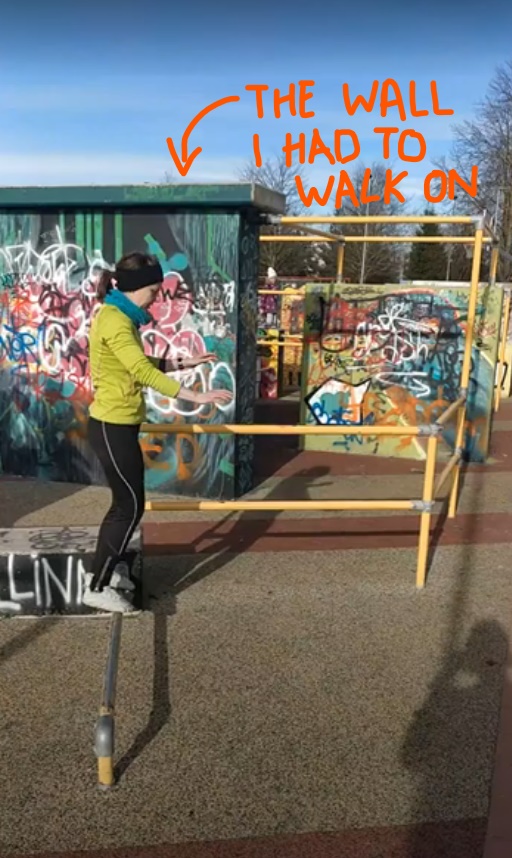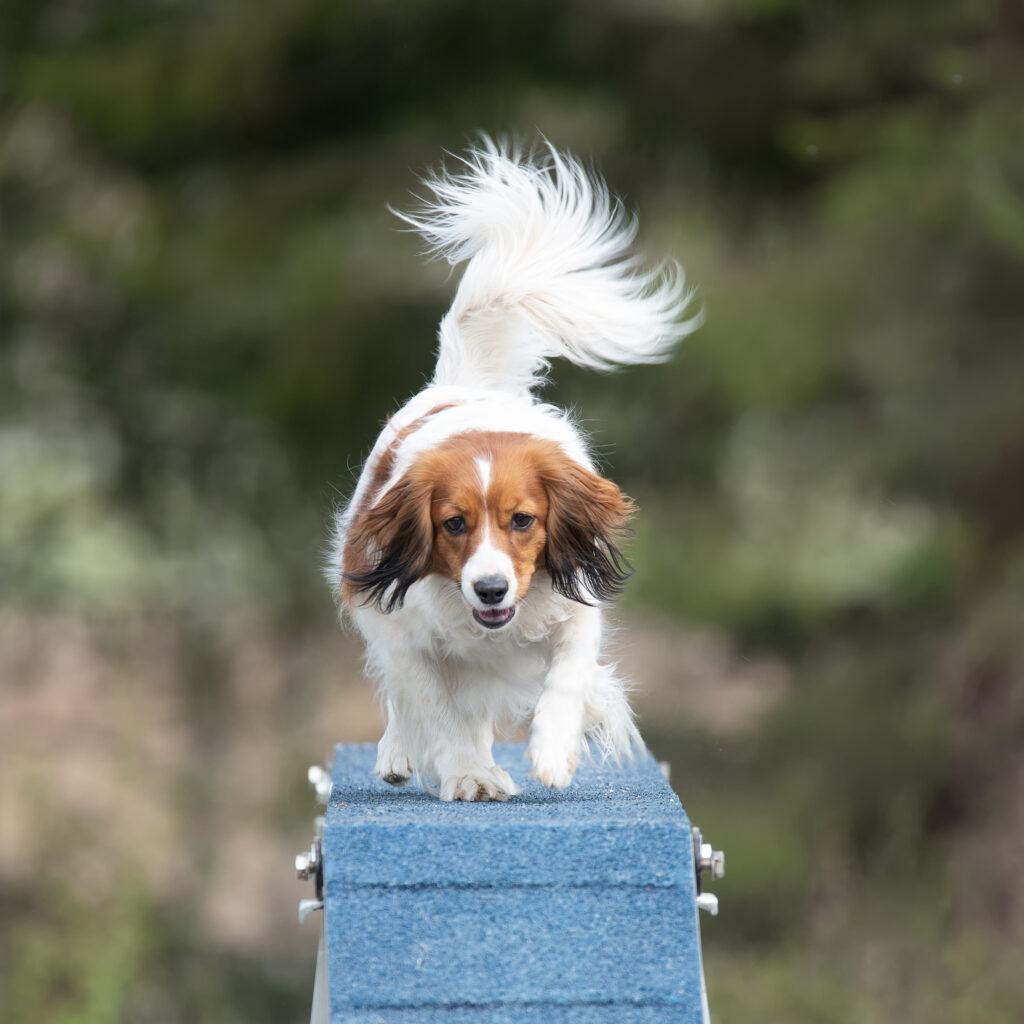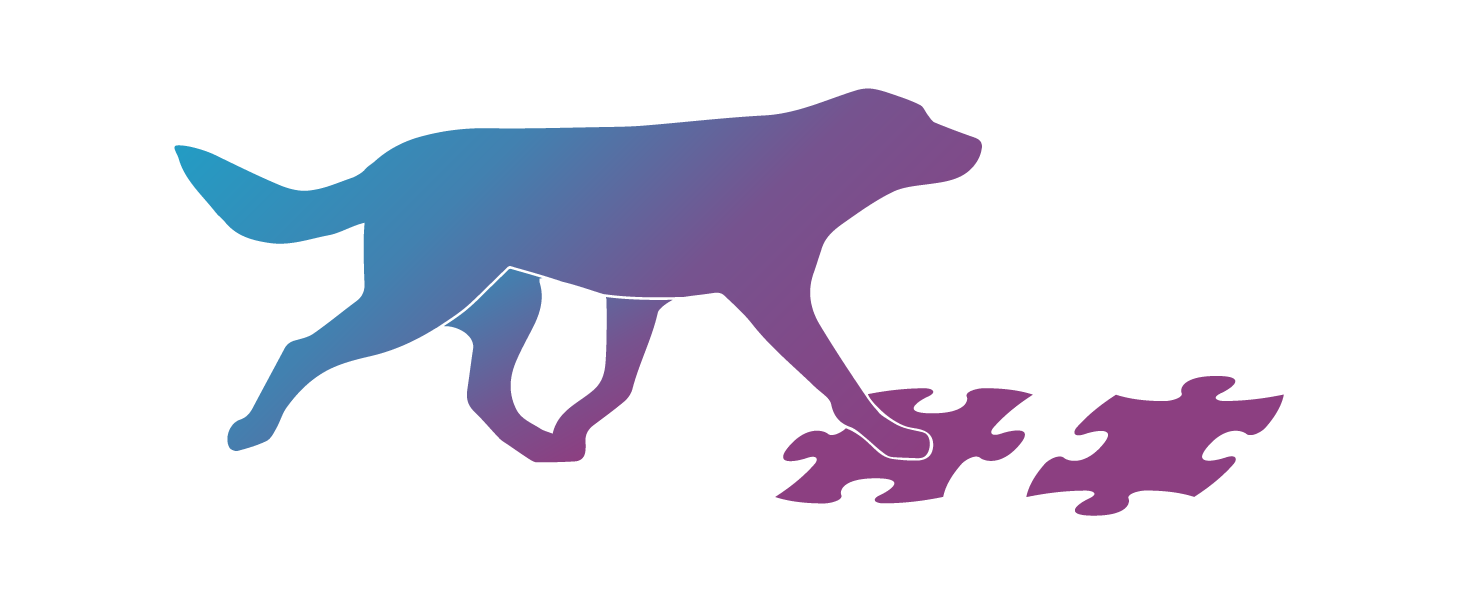Height is one of the biggest challenges of running the dog walk. It’s not only scary for us, the humans, worried about our dogs potentially falling off and injuring themselves…
It’s also scary for many dogs.

Few weeks ago my own balance and coordination coach decided to run our weekly training session in a local urban parkour park.
Here it is, a training ground full of high concrete walls, railings and other surfaces that allow training different parkour moves like running on the walls, hanging from railings and jumping from one railing to another.
For one of the exercises I was supposed to figure out how to circle the park without touching the ground. And that means I had to climb on top of this wall (in the photo) to get across that section of the park.
And it was freaking scary, walking on top of that wall. And it was about 60cm/2ft wide, giving me plenty of space.
When close to the ground, I can easily balance and walk on a narrow railing… But high up from the ground I became acutely aware of my width with respect to the environment (the wall I was walking on), affecting my ability to balance and actually place my feet on the wall with precision.
The same happens to our dogs.
Doing exercises close to the ground may be easy, leaving you thinking that your dog has great body awareness and balance for any sport challenge.
But adding height changes things. It makes your dog’s ability to balance and coordinate his movement a lot more difficult.
It’s the same as adding any other environmental distractions – some dogs may lose focus when there are other dogs running around them. Others may find humans incredibly distracting. Or maybe you can’t leave food or toys on the ground during your training session because then your dog can’t focus on the exercise criteria properly.
Then what do you do about these distractions? Most likely you start training, first keeping the distractions far away and then gradually making them more intense while making sure your dog can still focus well on the actual sport or work exercise.
It’s the same with height. If height affects your dog’s performance, then you want to start working on that. First doing exercises with low heights and gradually increasing the height. Always observing that your dog’s performance quality doesn’t change when adding height.
How do you know if height affects your dog’s performance on the dog walk?
Usual symptoms include your dog:
- slowing down when running over the highest part of the DW
- making lots of smaller steps on the DW
- avoiding the DW and looks a bit unsure when getting on
- struggling with hitting the contact zone when increasing the height of the DW
What can you do about it?
One of the most common options is to start training with a low dog walk and gradually increase the height, always making sure your dog is performing well with the slightly higher surface.

But that only helps if your dog isn’t exactly scared of the heights. If your dog shows any of the symptoms mentioned above, he may need a different approach.
And that is teaching your dog how to use his body on higher surfaces! Including doing body awareness, balance and coordination exercises not close to the ground anymore, but adding height as a “distraction” to these exercises.
Like in my story above – doing exercises higher from the ground instantly affected my balance and coordination, making normally easy exercises super challenging.
The way I see “height training” is first adding height to easy body awareness and balance exercises, making sure your dog is really comfortable moving his body in easy setups higher from the ground. And gradually build her confidence from there, including more height and movement to the exercises
What exercises would these be?
Unfortunately I can’t give exercise advice with heights here on this blog due to safety reasons. If you start adding height, there’s instantly a higher risk of injuries and accidents and I can’t recommend doing it without supervision.
However, if you do suspect that your dog is worried about the height of the dog walk and his performance drops at the full height, check out my course Beyond Dog Sports: Dog Walk or send me an email at mari@themovingcanine.com to see if my course would be a good fit for you and your dog.
At the end of May we are starting an instructor guided challenge inside Beyond Dog Sports: Dog Walk to target the fear of heights in a safe setup. If you join the course now, you’re just in time to get the foundations in place by the start of this challenge 🙂
Happy training!
Mari Valgma, CPCFT

